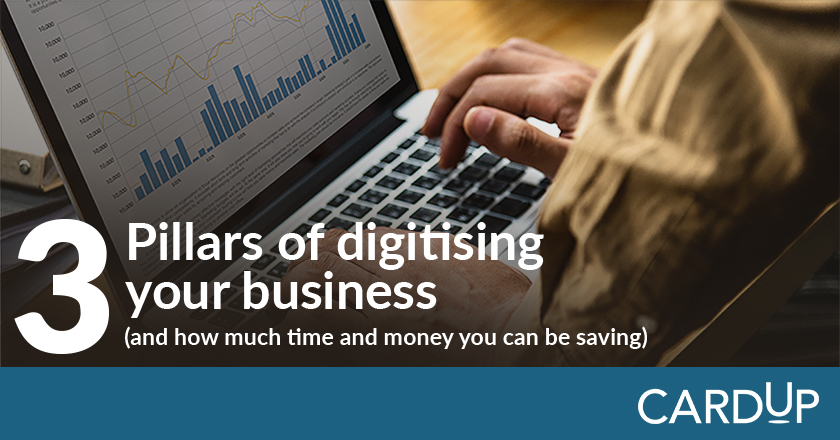The 3 pillars of digitising your business
The CardUp Team
Mar 19, 2019 6:12:00 PM


With the world of business moving faster each day due to the advancement of data and digital communication, there are more opportunities than ever before for businesses to leverage the changing landscape to improve productivity. If you’re running a small or medium-sized enterprise (SME), you’ve probably heard of the new government initiatives aimed at increasing business productivity, such as the SME Go Digital initiative, the implementation of nationwide e-invoicing, and other Smart Nation initiatives for both individuals and businesses.
But the push for more efficient and resilient business operations leveraging digital technologies requires a lot of work. So, as a business owner, which aspect do you begin with?
Here are the three key pillars you should be looking at to digitise your business, which will not only save you time and money but also set your business up for sustainable growth.

Although it was one of the first core operations to go digital, accounting and bookkeeping software has continued to evolve over time. The ability to track your finances is important for your business as it enables you to forecast and plan for the future, and be fully audited and compliant.
Xero is one of the most established options in the industry, and for good reason. The tool continues to grow its capabilities, providing easy access to your financial data and features such as near real-time views of your inventory and bank account.
Other options include Financio and Freshbooks, which have features better suited for different sectors and company types.
Estimated time saved per week: Most bookkeeping work can take upwards of 20 hours per week, and you can expect to cut that number in half with digitised bookkeeping.
| Activities | Time saved | Estimated cost savings |
|
10 hours per week | $5,840 per year |

Invoicing looks very different now to how it looked 20 years ago. In the past, if you were sending or receiving money, things moved much slower and involved complicated processes, with many inefficiencies like manual cash deposits and long cheque clearing times.
Now, you can provide a valid bank account and start receiving payments in a few days, or in many cases, instantly. The Singapore Government is also working towards implementing a nationwide e-Invoicing framework, which will bring about even faster payment cycles.
In addition, new tools such as credit card enablement platform CardUp for Business open up even more possibilities. Business owners now have new ways to:
Estimated time saved per week: As one of the most time consuming set of tasks there is for a small business, expect to cut your time spent from around 20 hours per week to approximately 8 hours.
| Activities | Time saved | Estimated cost savings |
|
12 hours per week | $7,010 per year |
|
4 hours per week | $2,330 per year |

Converting traditional human resources and payroll functions to digital platforms is a newer development which is rapidly growing. Benefits include smoother experiences and faster onboarding of new employees, along with easier management of leave, employee benefits, training and development.
Newer HR and payroll software also track changes to labour laws and come with automatic regulatory updates, saving time from manual calculations or amendments. They also work with integrated apps such as accounting software or external bank portals, saving even more time for your HR departments.
Moving these functions into a cloud solution like Talenox can also help with talent and retention. For younger employees in particular, being able to understand and easily adjust payroll and benefits options without scheduling a meeting is an expectation.
Estimated time saved per week: 6 hours per week, more during peak hiring and payroll times
| Activities | Time saved | Estimated cost savings |
|
6 hours per week | $10,480 per year |
| Total time saved | Estimated total costs saved |
| Approx. 1,352 hours per year |
Approx. $25,660 per year, per two employees (Accounts Assistant and HR Manager)
Upwards of $76,000 per year for larger Finance / HR Teams for SMEs |
Regardless of which industry your business serves, quickly leveraging on these digital tools and government initiatives can set you ahead of most other SMEs. Using digital tools in these three areas will save you time and money, help accelerate the growth of your business, and increase your ability to reach and service customers as Singapore continues to embrace digitisation.